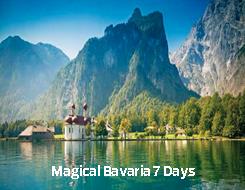In the south of Germany sits the birthplace of many fairytales inspired by magical surroundings and castles. A place where the meadows are a pleasant sight and walled towns from the medieval times continue to flourish. Bavaria is cozy and dreamlike, with the Bavarian Alps rising along the border to Austria.
60-Second Geography
Bavaria, Germany
|
Bavaria with SITA World Tours

|

- The largest city in Bavaria is Munich. Munich, the capital of Bavaria, is a city of art and beer. Breweries have strict standards on their processes, making it some of the finest brew in the world. But, along with this draw is the art held in the over 80 museums and galleries that showcase a long history of documenting culture through paintings and other mediums. What it is most known for is one of the ultimate parties, Oktoberfest. Locals don the green, brightly embroidered overalls and celebrate like few places on Earth. The traveler will find Munich to be the quintessential Bavarian experience in a city.

- The second-largest city in Bavaria is Nuremberg. Once the unofficial capital of the Holy Roman Empire, and the origin point of anti-Semite sentiment started by the Nazi party, Nuremberg has grown to become a better version of its previous self. The stonework of Gothic churches and well-preserved Nuremberg castle are sites that the traveler will love to take in. For those interested in the history of the National Socialist regime, Nazi party, the Documentation Center Nazi party Rally Grounds is a stark reminder of the past. These unfinished rally grounds were to be the ultimate staging ground for the party, left unfinished and standing as an example of politics gone wrong. Modern Nuremberg is beautiful, noting its own history with an educational nod to the future and ready for the traveler.

- Another location of note is the village of Berchtesgaden. This Alpine village sits at the foot of Mount Watzmann, just along the border to Austria. Once home to Hitler’s mountain retreat, Mount Watzmann is the third-largest mountain in Germany. Berchtesgaden is a traditional Alpine village with attractions such as salt mines, Lake Königssee , and the Eagle’s Nest. The Eagle’s Nest (Kehlsteinhaus in German) is a Nazi building at the summit of an outcrop overlooking Berchtesgaden. Though, visiting the Eagle’s Nest may depend on the weather conditions. This village has a great view of German mountains and forests, and represents a traditional Alpine village.
The traditions of German culture remain prominent in Bavaria, running as deep as the land is gorgeous. Mountains, Alpine villages, immersive architecture, castles, and excellent food and drink are readily available. That’s why SITA World Tours wants you to know that travelers will be overjoyed to experience the sites and festivities of Bavaria. With stopovers in Bavaria and much more of Europe, they’re ready to show the best of Germany. |
|

|
|
|
|
|
|
|
|
© Copyright 2019 Travmarket. LLC.
Travel Agents: You can use the content above on your own website or newsletter, compliments of the supplier sponsor above who has paid for your use of the materials. All you need to do is to follow the directions in the TRO Licensing Agreement. Also, please take a moment to check out the travel supplier that makes your use of this material possible. To use – Follow the procedure outlined in the TRO Licensing Agreement. Then, right click on this page and choose “View Source”. Copy the HTML and paste the copied HTML into your own webpages or newsletter. You may remove advertising










